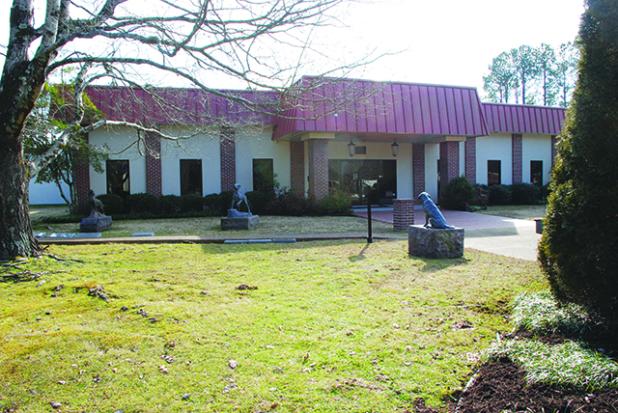
National Championship Celebrates 125 Years
The 125th running of the National Field Trial Championship begins on Monday, February 12 on the grounds of the Ames Plantation, home to the National since 1915. This prestigious event for sport dogs was first held near West Point, Mississippi in 1896; it was next held in several different locations in the area before finding its permanent home at the Ames Plantation.
A field trial is a competitive event at which sporting dogs compete against one another. Among the various sporting breeds, the most prevalent events are field trials for retrievers, pointing dogs, and flushing dogs. Field trials are usually organized by kennel clubs, breed associations, or other gun dog organizations. Field trials are generally considered more competitive than hunt tests in that success at a field trial requires a higher level of training than success at a hunt test requires.
The National usually has about 36 sporting dogs competing, and each dog has won or placed in the 70-plus qualifying trials held throughout the United States and Canada. Judges for this year's championship will be Jadie Rayfield, Mount Pleasant, South Carolina, Tom Shenker, Hurtsboro, Alabama, and Dr. Stan Wint, Gardner, Kansas. Brace-by-brace synopses of this event are available on the Ames Plantation web site a few hours after each individual brace is completed.
Mr. Hobart Ames first judged the National Championship in 1902 and last judged it in 1941. Throughout his life, he was a National judge 31 times, more than any other individual. Mr. Ames developed the standards for field trials judging that are still in use today and bear his name - the Amesian Standard. Some of these standards are, “The dog under consideration must have and display great bird sense. He must show perfect work on both coveys and singles. He must be able quickly to determine between foot and body scent. He must use his brain, eyes, and nose to the fullest advantage and hunt the likely places on the course.”
During his many years of participation in the National, Mr. Ames only owned one dog who won it-Alambagh, a Setter who won in 1905. Another Ames-owned dog, Powhatan, would later come close to winning on three separate occasions.
The National Bird Dog Museum began in a room at Wilson’s Sporting Goods in Grand Junction that displayed the bird dog memorabilia collected by Mr. Wilson Dunn, who often referred to his collection as the “Bird Dog Museum”. During the National each year, Mr. Dunn welcomed many visitors to his museum. Garette Lockee was one of those visitors who shared Mr. Dunn’s appreciation for preserving the history of sporting dogs and field trial sport. Over several years they discussed the idea of a larger museum to highlight the sport, its participants, and its history. Both gentlemen would later be inducted into the Field Trial Hall of Fame for their participation in and contributions to the sport.
In 1988 the Bird Dog Foundation Inc. was chartered, and a museum fund-raising campaign was begun. By 1990, the needed funds had been raised to begin construction. Mr. Lockee and Mr. Dunn bought and donated the land for the museum site. The museum was dedicated and opened in February 1991. The 30,000 square foot facility is home to art, photographs, and memorabilia about the field trials, shooting sports, and over 40 breeds of bird dogs. It also houses the Field Trial Hall of Fame, the Sporting Dog Hall of Fame, the Retriever Hall of Fame, and the Wildlife Heritage Center.
“Before COVID we were seeing about 6,000 visitors each year”, said Tonya Brotherton, Executive Director of the museum. “Like a lot of places, we are trying to get our visitor numbers back up.” Over the past year, the museum has hosted visitors from Australia, China, Japan, and Russia, and all 50 states. “Most of the international visitors come with someone in the U.S. who is involved in the sport. The Russian delegation was also interested in our Southern accents and the way some of us use our hands so much when we talk.” Brotherton says the sport has a huge following in China, Japan, and Australia. The museum is expecting visitors during this year’s National from England, Scotland, and Canada, as well as a number of U.S. states. Brotherton adds that visitors are impressed at the size of the museum’s collections as well as the historical aspects of the exhibits.
“Many people enjoy seeing the old dog crates we have that were used when dogs were shipped by train to the National as well as to other competitions,” Brotherton said. “The crates were built so that compartments slid out for the dog’s food and water.” An interesting aspect of these crates is their rounded top. Brotherton explained, “the rounded top on the crate kept the crates and dogs from being stacked on top of one another for their trip. The crates on display were found in the back of a barn in New Hampshire and were restored and donated to our museum.”
The kick-off event to the National is the Hall of Fame induction ceremony honoring both people and dogs who have contributed to and excelled at the sport throughout their lives. Nominations are voted on by peers in the sport and then approved by various committees whose members are also involved in the sport. The museum will host other events during the National as well as being open for tours.
Brotherton says the museum hosts numerous bird dog-related events throughout the year, including educational opportunities for all ages. An annual Art Contest for various ages is held each year, and an essay contest is open each year to high school students. For more information about the museum and its activities, or to make a donation, visit their website at www.birddogfoundation.com
Photo: Building – National Bird Dog Museum, Grand Junction, Tennessee.
